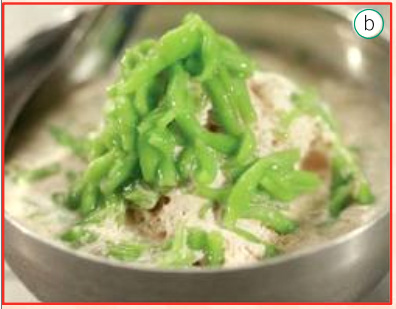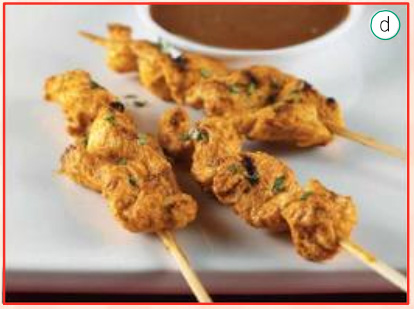Exercise 1
HUNGRY ADVENTURES
Travelling and eating around the world




‘Have you eaten?’ – May 13th
Singaporeans are my kind of people – they’re passionate about food and eating!
People here eat often – they have five or six meals a day. Instead of ‘Hello’ or ‘How are you?’ they ask, ‘Have you eaten?’. And it’s hard to believe just how many different kinds of dishes you can get in this tiny country – Chinese, Indian, Arabic, European and many, many more.
The best meal of the day today was lunch. The main course was muri ghonto or fish head curry – far more delicious than it sounds! It’s a southern Indian dish. You can have it with rice, but we had it the way that the Chinese do, with a soft bread roll.
Dessert was cendol – coconut milk, ice and green noodles. It’s a typical south-east Asian dish. It wasn’t as sweet as I expected, but the noodles were lovely – a bit like jelly.
There are places to eat here to suit everyone – from food stalls in shopping malls to more upmarket (and more expensive!) restaurants. My plan is to try as many as I can in the short time I’m here.
Hawker centres – street food, but not on the streets – May 14th
Singapore is famous for its street food, but it’s been illegal to sell cooked food in the streets for many years. So, if you’re looking for Singapore’s famous street food, hawker centres are the places to go. These are indoor food markets with stalls that sell freshly cooked food. You choose your hawker centre according to what kind of cuisine you fancy – Thai, Malay, Chinese, Indian, Middle Eastern.
I went to the Golden Mile Food Centre – it was amazing to see so many different food stalls under one roof. Sup tulang – a Malay-Indian dish of beef bones in a red spicy sauce – looked very tasty. But in the end I wanted something lighter, so I chose ayam buah keluak, a Paranakan (Chinese-Malay) dish. It’s chicken with Indonesian black nuts, served with steamed rice. A good choice – one of the most unusual dishes I’ve ever tasted.
Little India, big appetite – May 15th
This part of Singapore was full of the sights and smells of India. I ate thosai – crispy Indian pancakes made from rice and lentils. They were served with rich and spicy dips and vegetable curry. The meal was light and fresh – delicious!
Still full from my Indian lunch, I explored the Arab Quarter. There was plenty of great food on offer, but sadly I wasn’t hungry! I’ll have to come back to Singapore. I haven’t had a chance to explore Chinatown either.
By the evening I was hungry again, so I tried some of the barbecued food at Lau Pa Sat, an old market. I went for Malaysian chicken satay, pieces of chicken on sticks served with spicy peanut sauce. Absolutely delicious!
A. Read the blog. Find the descriptions of the dishes and match them with the food photos a—d.
1 chicken satay
2 muri ghonto
3 cendol
4 thosai
B. Read the blog again and answer the questions.
1 What two habits show that the people in Singapore love food?
2 What did the blog writer eat with her fish head curry?
3 Why can’t you buy food on the street in Singapore?
4 Why didn’t she have sup tulang at the Golden Mile Food Centre?
5 Why didn’t she eat anything in the Arab Quarter?
6 Which area of Singapore did she not go to?
Answer
A
1 d 2 c 3 b 4 a
B
1 They have five or six meals a day and they greet each other with the question ‘Have you eaten?’.
2 A soft bread roll.
3 It’s illegal to sell cooked food in the streets in Singapore.
4 She wanted something lighter.
5 She wasn’t hungry.
6 Chinatown
Exercise 2
CITY MAKES PROGRESS FOR DISABLED
This week is the first anniversary of mayor Alex Walker’s promise to make life in our city easier for disabled people. One year on, we asked disabled athlete Ayesha Omar to tell us about her experiences in the city.
Just over a year ago, City News invited me here for the day to do an interview; it turned out to be a visit I will never forget – unfortunately, for all the wrong reasons. As someone in a wheelchair, it was almost impossible for me to get around the city. There was not nearly enough access to public transport and I discovered that taxis were no better: none of them had the special doors I need to carry my wheelchair. The day was such a nightmare that I decided to write a story about my experience in the paper. After I wrote my story, mayor Alex Walker promised to make things better in the city and gave £6 million to the project. Last week, I returned to see if the city had improved.
I arrived at the train station early in the morning. One year ago, the station had only had stairs up to the exit. That meant that three men had to carry me off the platform which was by far the most embarrassing thing that happened to me during my last visit. This year, I saw immediately that they had built a new lift. ‘Wonderful!’ I thought – but then I remembered something – the buttons. On ‘normal’ lifts, the buttons are sometimes too high for a person in a wheelchair. That means that I have to ask someone to push the buttons for me. However, the lift in the station had buttons that were much lower so I was able to push them myself. I was really pleased with this.
I decided to take a taxi into the city centre, so first of all I needed to get some money from the bank. Again, I am very pleased to say that when I found the line of three cash machines outside the station, one of them was lower than the other two and so it was the right height for wheelchair users. Later that day, I took a bus and a tram and visited all the main museums, galleries and shopping centres. There was access for wheelchair users everywhere I went. Things are still not perfect and there is a long way to go but I can honestly say that Alex Walker has kept his promise to disabled people in the city!
A. Read the text. Are the sentences true or false?
1 This text is a newspaper article.
2 The writer’s name is Alex Walker.
3 The writer says that she enjoyed her first visit to the city despite one or two problems.
4 The writer says that the city has improved.
B. Read the text again and tick (✓) the correct answers.
1 How long has Alex Walker been mayor of the city?
a at least one year
b exactly one year
c less than one year
2 What does Ayesha say about taxis during her first visit?
a It was impossible for her to find one.
b She was not able to use them.
c They were better than public transport.
3 Why is Ayesha writing another report about the city?
a She had been invited to an anniversary party in the city.
b She has become a professional journalist.
c She heard that a lot of money had been spent on the city.
4 How has the train station improved since Ayesha’s last visit?
a Men are employed to help her get from the platform to the exit.
b She can get from the platform to the exit by herself.
c They have repaired the old lifts on the platform.
5 How many of the cash machines at the station can Ayesha use easily?
a one
b two
c three
6 How many different forms of transport did Ayesha use to get around the city?
a one
b two
c three
C. Think about the place where you live. How easy or difficult do you think it might be for wheelchair users to get around your hometown? Make notes about:
• public transport (do buses/trains/trams have disabled access?)
• things to do and places to visit (is it easy to visit a museum or go shopping?)
Use your notes to write a short review of disabled access for wheelchair users where you live.
Answer
A
True: 1, 4; False: 2, 3
B
1 a 2 b 3 c 4 b 5 a 6 c
